20 Types of Ducks in Arizona (with Pictures)
Last Updated on
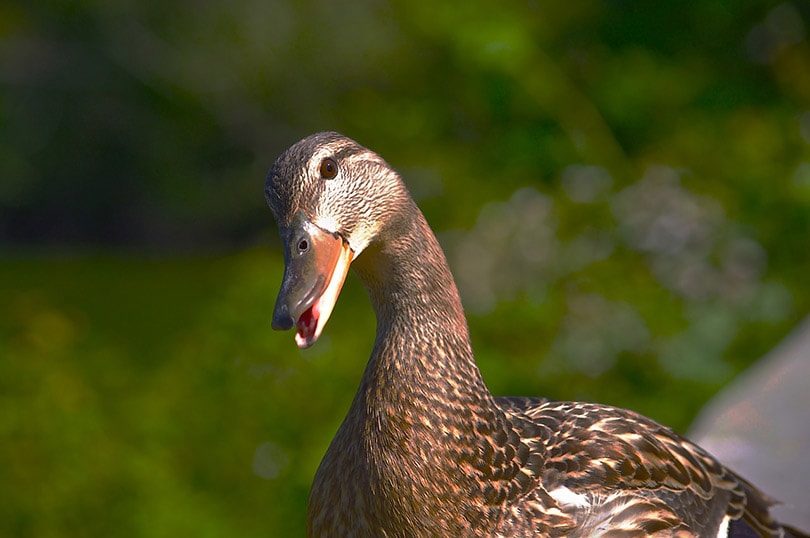
So, once you’ve finished your Grand Canyon tour, head out to lakes, rivers, and other wetlands to spot one (or more!) of Arizona’s 20 most common duck breeds!

The 20 Most Common Duck Breeds in Arizona
1. Mallard (Anas platyrhynchos)
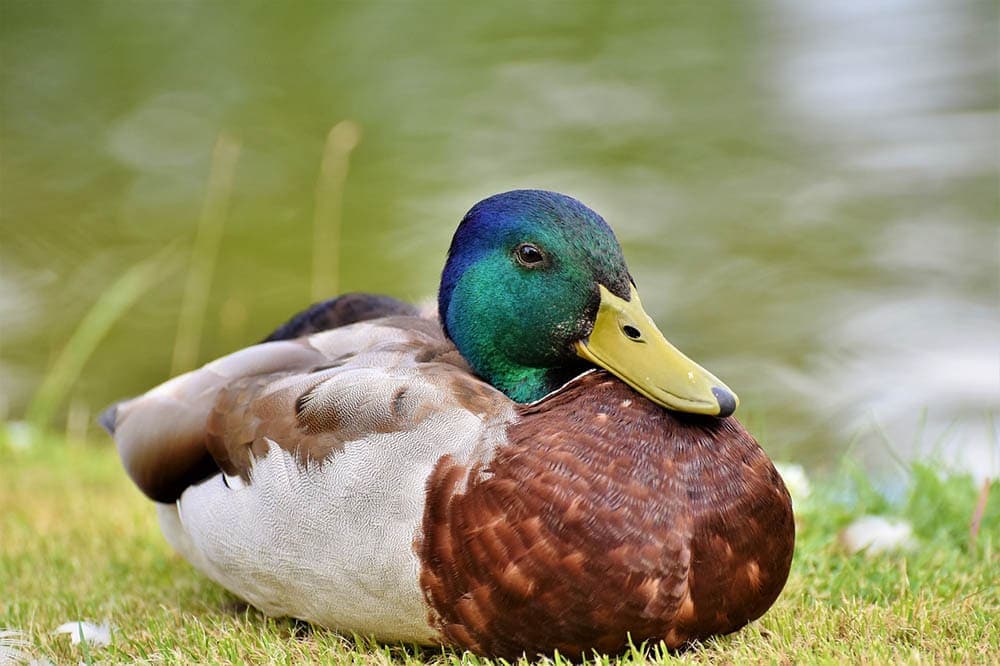
The Mallard is arguably one of the most recognizable ducks, with its bright green head, white collar, and yellow beak. Nevertheless, it is only the male who is fortunate enough to have such attractive plumage. In fact, the female has a duller plumage, spotted with brown; the only color that stands out is its orange beak.
This friendly and very common duck in Arizona is particularly fond of rivers, bays, lakes, and other areas where there are small freshwater streams. However, Mallards are not diving ducks. They will stick their head in the water to grab food but will only dive fully if the presence of a potential predator puts them at risk, which happens rather rarely. Thus, Mallards are considered dabbling ducks.
2. American Wigeon (Mareca americana)
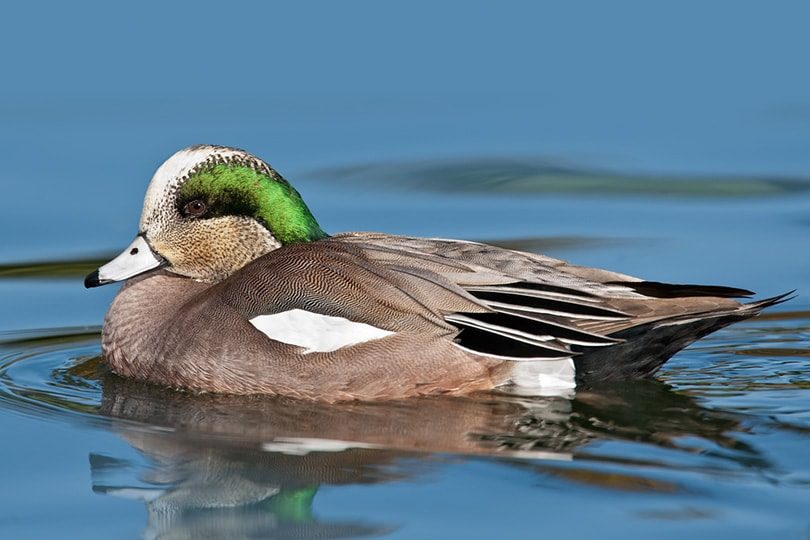
The male American Wigeon is a stocky duck and easily recognized by its small round head adorned with a green stripe, white crown, and white and black beak. Like the vast majority of female birds, the female American Wigeon has less impressive sand-brown plumage and a grayish beak.
This breed is more fearful than the Mallard and prefers calm lakes to areas more frequented by humans. Besides, the American Wigeon can be seen all over North America, but you will only come across it in Arizona during winter, where it can escape the bitter cold of Canada and the northern states of the US.
3. Eurasian Wigeon (Mareca penelope)

If you see an American Wigeon, there is a good chance that you will also be able to observe another species of the genus Mareca: the Eurasian Wigeon. Indeed, this species thrives in a habitat similar to its American counterpart; it is mainly found in lakes, marshy ponds, and sheltered bays.
Moreover, the Eurasian Wigeon male is a small, compact duck with a round head of a beautiful chestnut color. This contrasts sharply with the rest of its light gray plumage; the tips of the feathers are deep black. The female has a white belly and gray-brown plumage.
4. Gadwall (Mareca strepera)
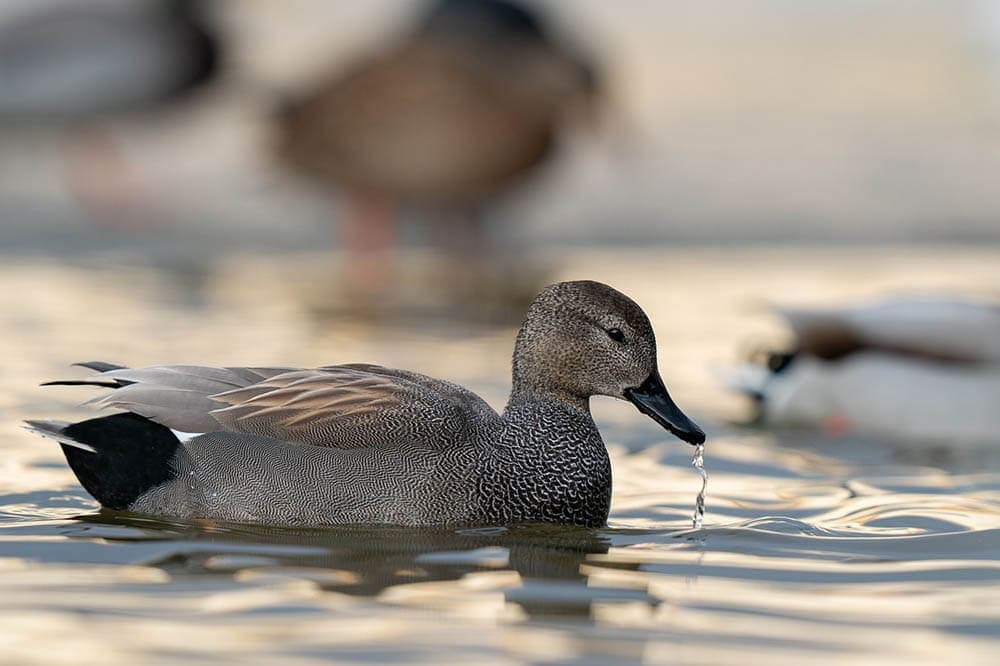
Gadwall ducks spend a lot of time splashing around in rivers, bays, lakes, and other shallow freshwater streams. But, unlike his counterparts, the male Gadwall duck does not sport flaming plumage. Its body is gray and speckled with white. The small, white, crescent-shaped hatching is larger on the brown chest.
The female has mottled brown plumage and an orange and black bill. The lower part of its chest and stomach are white. In addition, it has a white spot on the wing which helps to identify it and differentiate it from female ducks of other species.
Fun fact: Their short, clear calls are often described as “burps”.
5. Northern Pintail (Anas acuta)
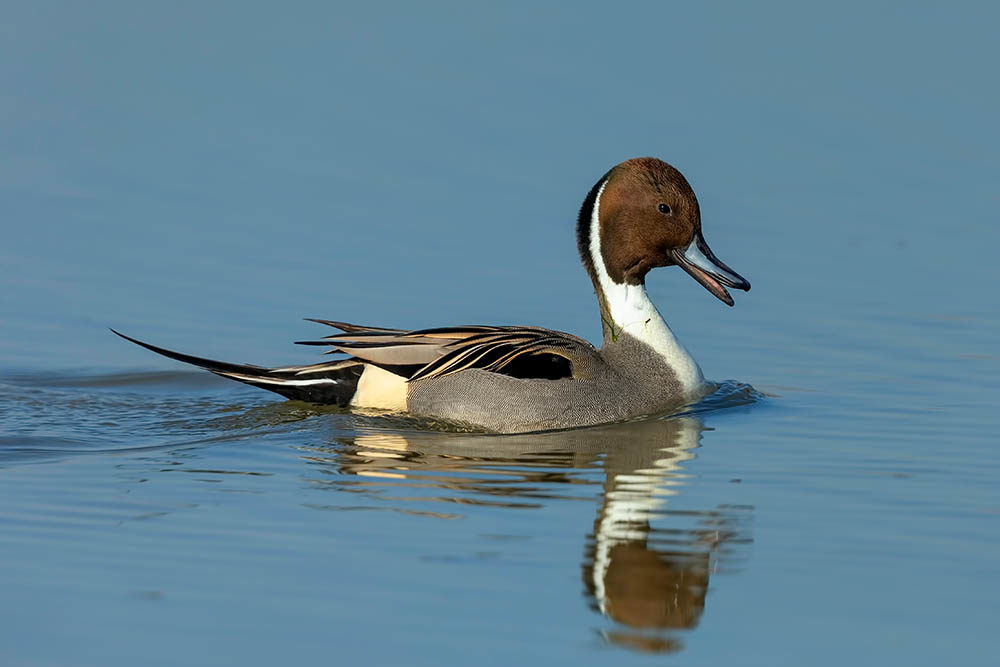
You will find the Northern Pintail in the wetlands of Arizona, but it usually stays away from people. This species has a distinctive slender profile, with a long neck and a very pointed tail. The upper side of its plumage is gray with some black on the wings and tail. The front of the neck, chest, belly, and rump are white. The head is gray with brownish reflections depending on the lighting. Moreover, its unique call resembles the whistle of a train.
The female also has a long neck, but its body is mottled brown, and its head is a solid brown. Legs and beaks are gray. In addition, females make more low-pitched calls than their male counterparts.
6. Northern Shoveler (Spatula clypeata)
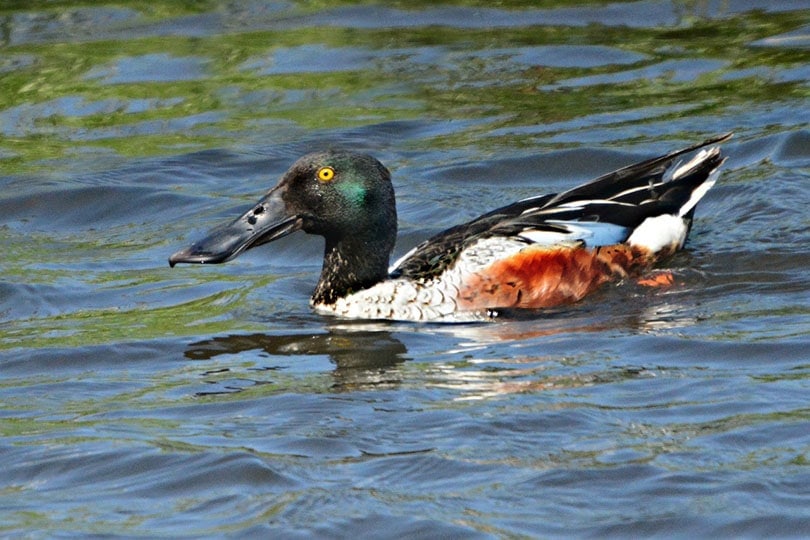
The Northern Shoveler may look like the Mallard, but it nevertheless has a very distinctive characteristic: its enormous spatula-shaped beak, visible from afar and even during its flight! It is also smaller than the Mallard, but the similar colors of the two species can, at first glance, mislead the inexperienced bird enthusiast.
In Arizona, this duck can be seen near areas of fresh or brackish water, such as marshes, lakes, ponds, or estuaries. However, outside of the breeding season, it will be more difficult for you to locate it since the Northern Shoveler becomes rather silent.
7. Blue-Winged Teal (Spatula discors)
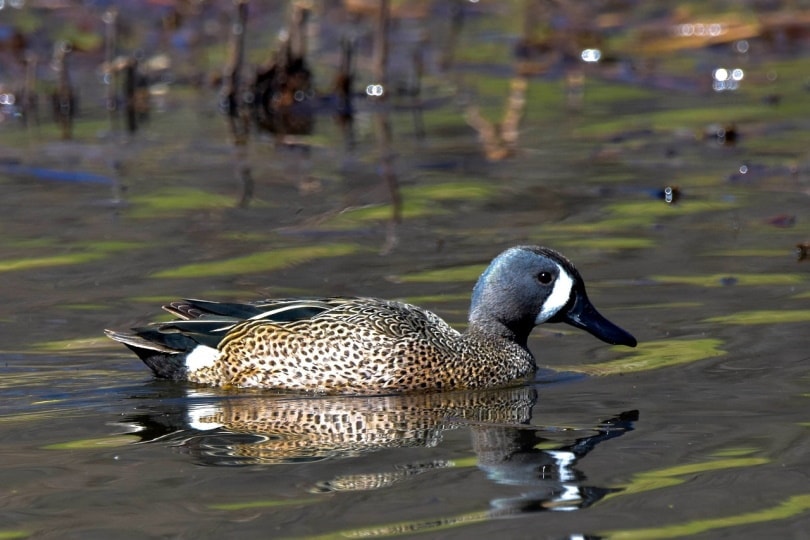
The Blue-Winged Teal is the second most abundantly found duck in North America, just after the Mallard. In Arizona, you will have the chance to observe it in shallow wetlands outside of the breeding season, from late December to late January.
One of its most striking features is the pale blue stripe on its wing, but it is only visible while in flight. The male’s head and bill are blue-gray with a white vertical stripe between the bill and the eyes. The body is mottled brown-gray and the back is also grayish with a black tail. The female is speckled with brown and gray and like the female Mallard.
8. Green-Winged Teal (Anas crecca)

The Green-Winged Teal is the smallest representative of North American dabbling ducks. It is abundant along rivers and forest-fringed wetlands, where it nests well in dense canopy, often in shrubs or tall grasses. It is very agile in flight and can also, in case of danger, dive and swim underwater over great distances. In addition, it is the second most hunted duck species in North America.
This little duck is distinguished by the green stripe on the back of the wing, visible in flight or when the bird is at rest. The male has a round chestnut head, a green band on the side of the ears, and a gray body streaked with white. The female has very common mottled brown plumage; without the green stripe on the back of its wings, it would be very difficult to distinguish it from other female ducks!
9. Cinnamon Teal (Spatula cyanoptera)

The Cinnamon Teal is among the least studied waterfowl species in North America. Therefore, information on the ecology of this species is still sketchy. In Arizona, you will find it in large wetlands with enough vegetation to allow it to hide from predators.
The male is recognizable by his red eyes, long black beak, and cinnamon plumage. During its flight, it exhibits magnificent green and blue stripes on its wings. The female is less conspicuous with its marbled plumage of brown and black eyes.
10. Wood Duck (Aix sponsa)
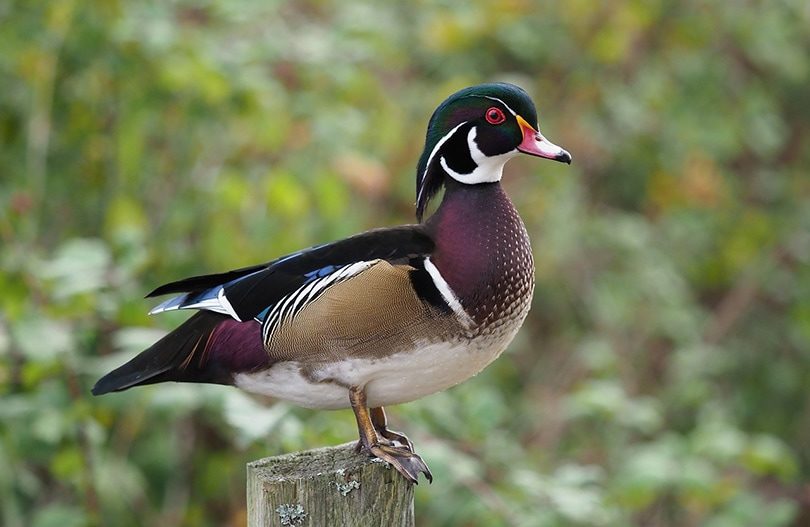
The Wood Duck is one of the most fascinating species of ducks that you will see in Arizona because its plumage is adorned with multiple and vivid colors. This magnificent bird stays close to the water but nests in a tree trunk.
During the nuptial period, the male is a true work of art: its head is adorned with a long crest that falls backward with shades of lime and purple. Thin white lines decorate its throat and neck. The bill is thin and orange, almost red, and curved at the tip. Its body and belly sport almost every color of the rainbow: purple, green, orange, pink, yellow, black, brown, and gray!
The female is less spectacular, with its plumage predominantly gray. A blue stripe on the wing is the only touch of color.
11. Black-Bellied Whistling-Duck (Dendrocygna autumnalis)

The Black-Bellied Whistling-Duck is one of the rare species of duck which does not exhibit sexual dimorphism: males and females have very similar plumages. This dabbling duck has a round, reddish-colored head with a cream midline that covers the forehead and crown. Its sides and back are grayish, its belly is white, and its chest is buff. It can be distinguished from the American Wigeon by the latter’s gray and green head.
12. Fulvous Whistling-Duck (Dendrocygna bicolor)
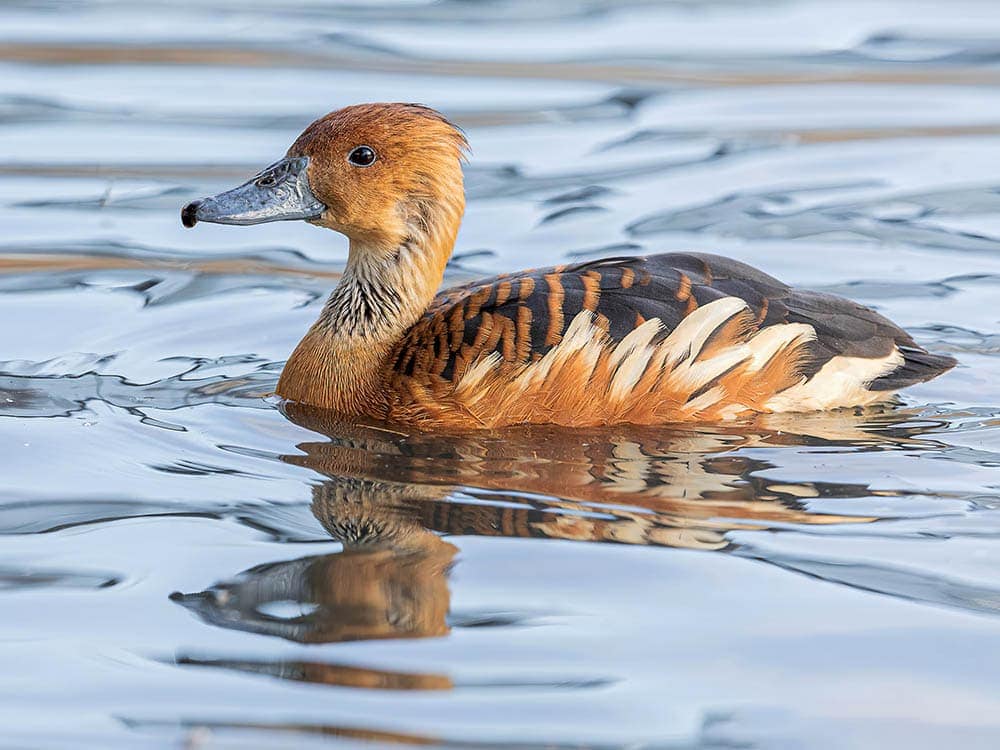
The Fulvous Whistling-Duck does not present pronounced sexual dimorphism either. This bird is reddish-brown with a darker back. The head is orange, the chin and throat are slightly white, streaked with black and forming a broad collar. The crown is a more intense red, while the belly is beige-orange.
This dabbling duck prefers wetlands and marshes. Above all, it seeks dense vegetation with tall grass to ensure its protection during nesting and molting.
13. Mexican Duck (Anas diazi)

The Mexican Duck lives mainly in the country of the same name, but it is possible to spot some individuals in Arizona. It is a dabbling duck that closely resembles the Mallard duck; it was long believed that they were part of the same species. In fact, both sexes look like a dark-colored female Mallard. The male’s bill is dull yellowish; the female’s beak is spotted with orange and black, like a typical mallard duck. However, in flight, the bright white underside of the wings contrasts with the dark body.
This duck is rather wary of humans, but it is increasingly found in urban areas.
14. Canvasback (Aythya valisineria)
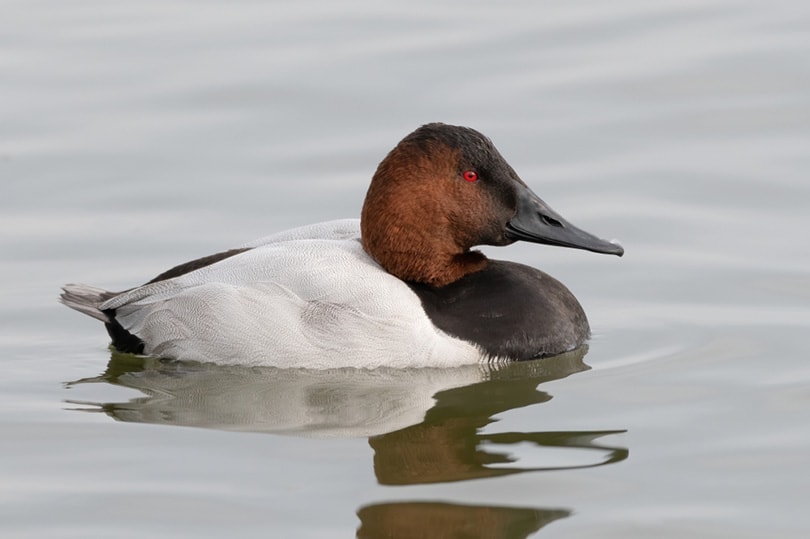
The Canvasback is a large diving duck, highly prized by hunters because of its delicate flesh. The male has a black chest and tail, red eyes, a brownish head, and a gray body.
The female is roughly the same size and has the same profile: receding forehead and long bill. However, it is less colorful and, therefore, more apt to blend in with the surroundings while brooding or raising its young.
Besides, the Canvasback is one of the most powerful flying ducks – it can reach 75 mph.
15. Redhead (Aythya americana)
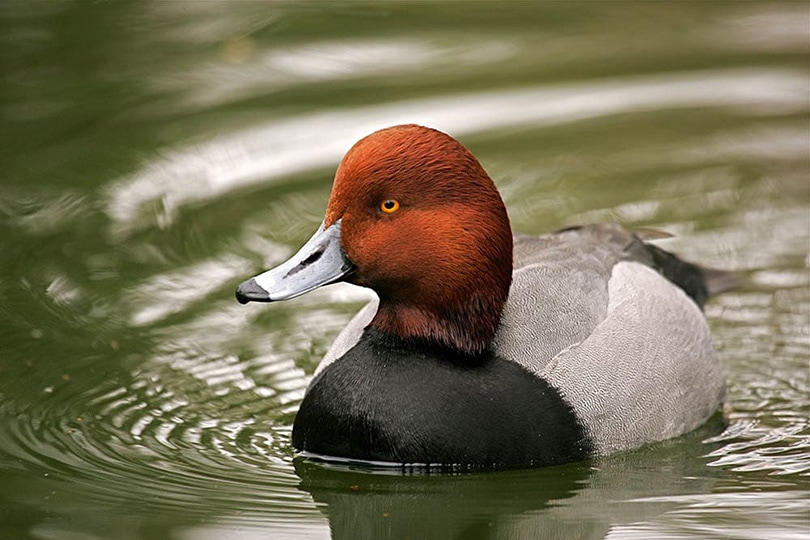
The Redhead is a well-known and widely distributed diving duck in North America. The adult male is a large duck with a gray back, white breast, a reddish-brown head, black neck, and throat. It resembles the male of the Canvasback. The female is a large, brown-backed, white-breasted, brown-headed duck with a short, broad bill and pearl-gray speckled wings.
In Arizona, these ducks are some of the friendliest ducks you will encounter. It is common to see them gathered in huge flocks, sometimes thousands, in relatively large lakes.
16. Ring-Necked Duck (Aythya collaris)

The Ring-Necked is a diving duck that you can observe in wetlands and shallow ponds in Arizona. The male has a beautiful shiny black head and yellow eyes. There is a white circle at the base of the beak and a larger one at the end. In addition, the tip of the bill is black, which is a distinctive sign of the Aythya species.
During the mating season, from October to June, and with favorable lighting, the male has purple reflections on the head, and a reddish ring around the neck, hence its name. However, you must be very close to it to be able to discern this famous necklace!
17. Tufted Duck (Aythya fuligula)

Another diving duck found in Arizona is the Tufted Duck. It is a black bird with a white belly and flanks. It has a distinctive crest of long feathers behind its head. Its flat, round bill is gray-blue with a black tip. It has a short tail, and his eyes are yellow. Its webbed legs are also bluish-black. The female is light brown with a darker back. It has a white spot above the beak, and a small crest on the head.
You can differentiate it from the Lesser Scaup by its long crest.
18. Greater Scaup (Aythya marila)

Of all the duck species found in Arizona, two of these species, the Greater Scaup and the Lesser Scaup, are closely related and are almost identical in general appearance, which can make them difficult to tell apart. The male’s head is dark green and his eyes are yellow. The breast and rump are black. The back is white with black stripes and the flank is white, while the bill is gray-blue with a black tip.
The round, green head helps distinguish it from the Lesser Scaup, although this is not obvious at first glance.
19. Lesser Scaup (Aythya affinis)

It is possible to differentiate the Lesser Scaup from the Greater Scaup by the smaller size of the former, as well as the purple reflections of the feathers on its head and neck. Its head seems to have a less round shape and its plumage has a higher rim towards the nape of the neck as if it was wearing a small hat. In flight, they can be distinguished by the small white band on the wings.
The female is brown with a white facial patch on the feathers surrounding the root of the bill. Besides, this diving duck likes to nest close to marshes, lakes, and marshy ponds.
20. Ruddy Duck (Oxyura jamaicensis)

The Ruddy Ducks are not an abundant duck species in Arizona, but they are some of the most fascinating to watch! Indeed, the male has a magnificent powder-blue beak, white cheeks, a big stocky chestnut neck, and a black crown. The female is, once again, duller than the male, but its large black spatula-shaped bill is also an interesting feature.

Conclusion
Now that you know a little more about the main breeds of ducks found in Arizona, go to the Arizona Bird Committee (ABC) website, and download the updated checklist. This will allow you to note all your observations on ducks and other birds during your next visit to Arizona!
Featured Image Credit by: VancouverLami, Pixabay
Table of Contents
- The 20 Most Common Duck Breeds in Arizona
- 1. Mallard (Anas platyrhynchos)
- 2. American Wigeon (Mareca americana)
- 3. Eurasian Wigeon (Mareca penelope)
- 4. Gadwall (Mareca strepera)
- 5. Northern Pintail (Anas acuta)
- 6. Northern Shoveler (Spatula clypeata)
- 7. Blue-Winged Teal (Spatula discors)
- 8. Green-Winged Teal (Anas crecca)
- 9. Cinnamon Teal (Spatula cyanoptera)
- 10. Wood Duck (Aix sponsa)
- 11. Black-Bellied Whistling-Duck (Dendrocygna autumnalis)
- 12. Fulvous Whistling-Duck (Dendrocygna bicolor)
- 13. Mexican Duck (Anas diazi)
- 14. Canvasback (Aythya valisineria)
- 15. Redhead (Aythya americana)
- 16. Ring-Necked Duck (Aythya collaris)
- 17. Tufted Duck (Aythya fuligula)
- 18. Greater Scaup (Aythya marila)
- 19. Lesser Scaup (Aythya affinis)
- 20. Ruddy Duck (Oxyura jamaicensis)
- Conclusion
About the Author Genevieve Dugal
Genevieve is a biologist and science writer and has a deep love for capuchin monkeys, pumas, and kangaroos, which has taken her around the world to work and volunteer for several wildlife rehabilitation centers. A Canadian expat, Genevieve now lives in Argentina, where she wakes up every morning to horses and cows saying hello from the vast plain next to her home office window. Having the privilege of sharing her knowledge and passion for animals of all kinds is what makes her fulfilled and happy.
Related Articles:
Monocular vs Telescope: Differences Explained (With Pictures)
10 Types of Hummingbirds in Arkansas (With Pictures)
8 Types of Hummingbirds in Nebraska (With Pictures)
5 Types of Hummingbirds in Idaho (With Pictures)
3 Types of Hummingbirds in Mississippi (With Pictures)
8 Types of Hummingbirds in Kansas (With Pictures)
5 Types of Hummingbirds in West Virginia (With Pictures)
5 Types of Hummingbirds in Ohio (With Pictures)
